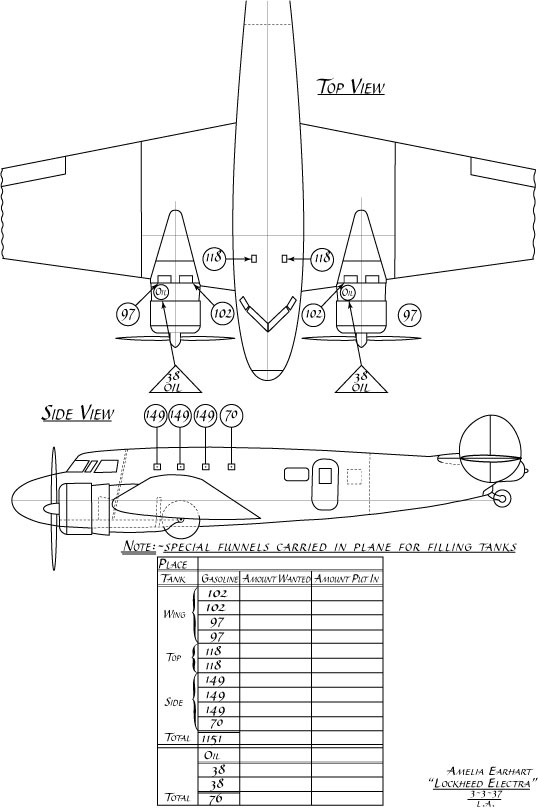 |
Earhart Project Research Bulletin
November 1, 2011
| The Fuel System of NR16020 |
These photos and documents detail the evolution of the Earhart Electra’s fuel system.
|
||
Earhart Project Research Bulletin |
||
|
||
These photos and documents detail the evolution of the Earhart Electra’s fuel system. |
||
This photo was probably taken in April or May of 1936 when the Electra was under construction. The camera is looking forward toward the cockpit. Amelia is sitting on the “Main Beam” that runs through the wings and fuselage from engine to engine. The cabin is still bare aluminum. None of the fuel system plumbing is yet in place. |
Still under construction. A foil condensation barrier has been applied to the bare aluminum. The cockpit is nearly complete and the door has been hung. The cabin heating ducts have been installed along the base of the wall. Three fueling ports have been installed – two on the left side of the cabin and one in the top left. The tubes along the cabin wall are believed to be manifolds for the fuel tank vents. The dark objects on the floor are cradles for the fuselage tanks. |
This photo was taken around the time the airplane was delivered to Earhart in July 1936 and, for some reason, was crudely retouched to soften the background. It shows that in the original configuration there were only two fuel filler ports on the side of the fuselage. |
|
This picture was probably taken during the same photo op (AE is dressed the same). The filler ports are the same as in the photo of the plane when it was under construction. The forward port on the cabin wall serves two tanks via a manifold. When delivered, the airplane had a total of 13 separate fuel tanks:
|
Apparently there were problems with the original manifold arrangement because in late September, when Earhart visited Purdue University to show off her new plane, there were four fuel filler ports on the side of the fuselage. It’s hard to tell whether there is also a separate filler port for the starboard side 118 gallon tank. On October 29, 1936 George Putnam wrote to the Bureau of Air Commerce to straighten out some confusion about the airplane’s license which described it as having a fuel capacity of only 394 gallons. The airplane had originally been licensed by Lockheed in the Experimental category with the 1,198 gallon system. After it was sold to Earhart, she licensed the Electra in the Restricted category in August during a brief period when the fuselage tanks had been removed to install a “false floor” (no explanation). The airplane had never, therefore, been licensed in the Restricted category with the long-range fuel system installed. In the October 29 letter Putnam stated that “the existing tankage ... is identical with that in the ship at the time of the first license.” In other words, 13 tanks totaling 1,198 gallons. |
In October 1936, Earhart flew the Electra to Wright-Patterson AFB in Dayton, Ohio where inventor Fred Hooven installed and tested his Radio Compass, later known as an Automatic Direction Finder or ADF. The receiver was mounted on one of the fuselage tanks forward on the starboard side and the loop antenna was housed in a faired dome on top of the cabin. |
|
This is a sketch that accompanied the November 27, 1936 Bureau of Air Commerce Inspection report. The photo of the cabin interior below was taken some time between November 27, 1936 when the tankage changed and February 1937 when a navigator’s station was built behind the last fuel tank in preparation for the world flight. The Hooven Radio Compass was removed the first week of March 1937. The cabin has been furnished with a cloth headliner.
|
|
Details of the valves:
|
|
A new filler port was added forward of the first one and what had been the second filler port was skinned over with a patch. This photo was taken after the loop was installed in the first week of March 1937 but, based on the spacing of the ports, the change seems to have been made by the time the photo of tanks in the cabin was taken. |
|
 This is a form that was created on March 3, 1937 to be used to order fuel during the world flight. This is an accurate facsimile of the original document that has been cleaned up for the sake of legibility. This is a form that was created on March 3, 1937 to be used to order fuel during the world flight. This is an accurate facsimile of the original document that has been cleaned up for the sake of legibility. |
|
|
||||||||||
|
|
||||||||||
|